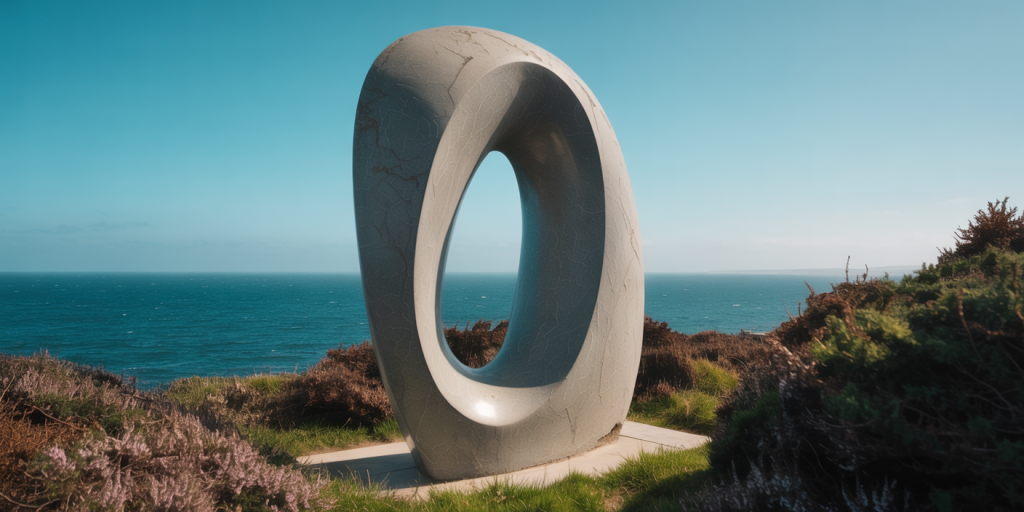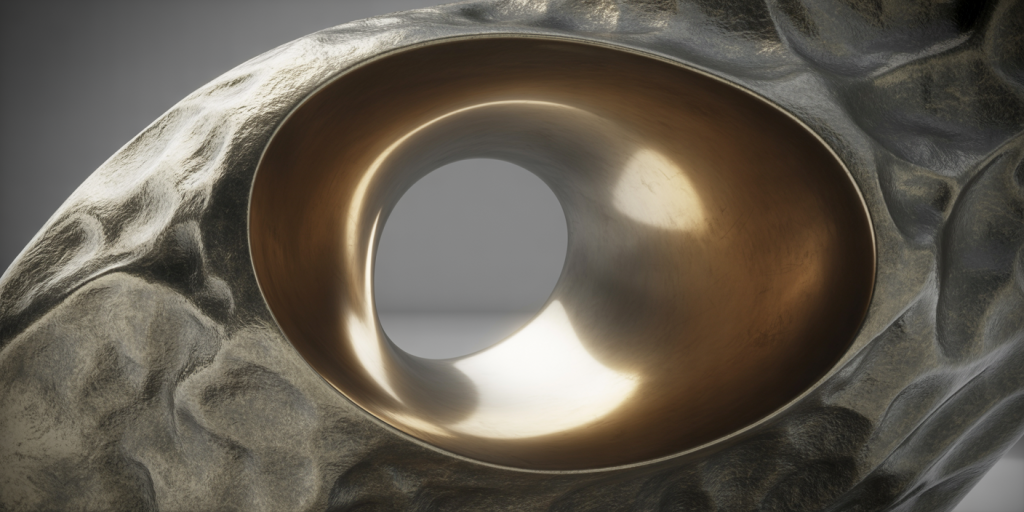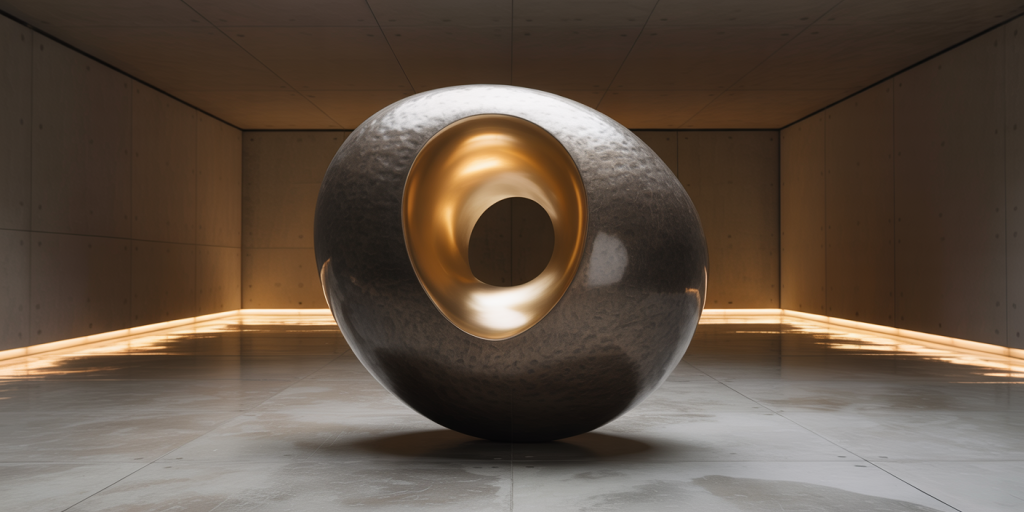In the Center of the Void, Barbara Hepworth Hears the Wind Think
There is a silence that echoes louder than sound, a stillness that pulses with unseen motion. In the hollow heart of Barbara Hepworth’s sculpture, time inhales. We do not merely stand before her work; we stand within it, wrapped in its breathless circumference. The wind brushes through the void, a sigh made solid, a whisper carved from stone. One does not view her sculpture from the outside. One listens. And what we hear is the thought of the wind.
This is not absence. It is presence in its most distilled form. A space defined not by what it contains, but by what it releases. Hepworth’s sculpture is a sanctum of negative space, a cathedral of hollowness, where the sacred speaks without a tongue.
Table of Contents
- The Void as a Pulse
- A Dialogue Between Air and Stone
- Where Light Slips Through Intention
- The Caress of Curvature
- When Silence Has Contour
- Polished Edges of Inner Sound
- The Moon Trapped in Marble
- A Sculpted Breath
- From Cornwall, the Wind Whispers
- Pierced Forms and the Memory of Hands
- Geometry of Listening
- Shadows Woven into Form
- Matter as Meditation
- The Vessel of the Unspoken
- Feminine Essence in Negative Space
- Sculpting the Soul’s Alcove
- The Haptics of Emptiness
- Hepworth and the Language of Hollow
- The Poise of Tension and Tranquility
- Listening to the Sculpture Think
The Void as a Pulse
In Hepworth’s world, the void is not absence but rhythm. The hollow center pulses not with vacancy, but with life. It is the breath between words, the heartbeat of form. Her sculpture is the embodiment of spatial awareness—not solid mass, but the tension between touch and release.
This central emptiness does not retreat. It demands attention. It glows. Framed by elegant contours, it becomes a living entity, the invisible protagonist of a story in bronze, marble, or wood.
A Dialogue Between Air and Stone
Barbara Hepworth did not carve alone. She invited the air to sculpt with her. Her pierced forms allow atmosphere to become collaborator. The sculpture is no longer static; it shifts with weather, with the sun’s orbit, with the passing viewer’s shadow.
Air enters and leaves like breath through a lung. Stone holds the form, but air grants it voice. This is a duet, composed in silence, sung in light.

Where Light Slips Through Intention
Light does not fall on Hepworth’s forms; it enters them. Through the voids, it paints the inner walls, curves, and recesses. The sculpture becomes a lantern of daylight, a vessel for illumination.
These inner glows change through the day. Morning reveals subtle veins in the stone, while twilight drowns the interior in shadow. The sculpture is not one object, but many, changed by sun and season.
The Caress of Curvature
There are no sharp angles in Hepworth’s vocabulary. Her language is round, feminine, cellular. Her forms echo the body—not its likeness, but its essence. Wombs, ears, eyes, seeds, planets. These are not metaphors, but echoes.
The curves draw the hand before the eye. You wish to touch, not to see. Even in stone, they feel soft, skin-like. They do not resist. They invite.
When Silence Has Contour
The silence within the void is sculpted. It has shape, slope, a quiet architecture. This is not silence as lack, but silence as presence—the kind found in chapels and tidepools.
The void is an ear, perhaps. It listens. Not to us, but to itself. The sculpture is a listening post for the world’s hush.
Polished Edges of Inner Sound
Hepworth often polished the interior hollows to a gleam. This juxtaposition—matte exterior, glossy inner wall—is not decorative. It is conceptual. The outside may be weathered, but the soul shines.
This dichotomy invites meditation. The viewer senses something sacred is held within. A pearl, a secret, a note still ringing.
The Moon Trapped in Marble
Certain sculptures resemble celestial bodies—not in scale, but in presence. The round void, the surface flecked with light and age, recall the moon. A cosmic relic shaped by human hand.
This moon, however, does not orbit. It anchors. It pulls us inward, not upward. Gravity is spiritual here.
A Sculpted Breath
What Hepworth carves is not mass, but pause. A breath given form. Her sculptures inhale. They rest. They exhale memory.
This breathing is not metaphorical alone. One stands before the work and begins to breathe differently. Slower. Deeper. The sculpture teaches rhythm.
From Cornwall, the Wind Whispers
Hepworth’s studio overlooked the sea in St Ives. Wind, salt, and wave were her constant companions. Her forms remember this.
The wind passes through her sculpture as if returning home. The void is a window to the coast, a cave for the tide to dream in.
Pierced Forms and the Memory of Hands
Barbara Hepworth was one of the few modernists who carved with her own hands. Her tools left memory in the stone—not fingerprints, but intentions. Her sculptures are not anonymous.
The piercing of forms was revolutionary. No longer did sculpture enclose space; it conversed with it. The void is the point where the hand yields to air.
Geometry of Listening
Her forms suggest geometry but defy mathematics. Circles, ellipses, ovals—none perfect, yet all precise. This is not cold logic, but warm proportion.
The void becomes a listening chamber. Like a seashell, it catches whispers of the world and returns them transformed.

Shadows Woven into Form
The void casts shadows inward, lacing the sculpture with time. The inner surfaces darken and brighten, weaving shadows like thread through lace.
Hepworth sculpts light indirectly. She sculpts what light becomes when shaped by absence.
Matter as Meditation
To look upon Hepworth’s work is to enter a meditative state. The repetition of form, the serenity of surface, the hush of negative space—all converge into contemplation.
Her sculptures are not statements, but questions. They ask quietly, endlessly, who are you when you are still?
The Vessel of the Unspoken
Each hollow is a vessel, not of things, but of thoughts never voiced. These are not declarative objects. They are waiting rooms for the unsaid.
The sculpture holds memory like a cupped hand holds water. Gently. Fleetingly.
Feminine Essence in Negative Space
There is a maternal quality in Hepworth’s work. Not softness alone, but containment, protection, gestation. The voids become wombs of reflection.
This is femininity as architecture. Strength through curve. Depth through openness. Creation not by addition, but by embrace.
Sculpting the Soul’s Alcove
These works are not monuments. They are alcoves for the soul. Not built to tower, but to cradle.
In the void, one finds shelter. Not from weather, but from noise. Not from the world, but from its forgetfulness.
The Haptics of Emptiness
Though made for the eye, Hepworth’s sculpture is tactile in intent. One imagines tracing every edge, resting the hand inside the void, feeling the cool smoothness.
The absence becomes tangible. One does not grasp it, but is grasped by it. The void holds.
Hepworth and the Language of Hollow
She carved a new language, not of lines but of lacunae. Her grammar is elliptical, her syntax sculptural.
To read her work is to become fluent in the eloquence of space, the dialect of what is not there.
The Poise of Tension and Tranquility
Her forms balance tension and rest. The stringed sculptures, with wires stretched across voids, sing of equilibrium.
Even the solid pieces carry this poise. The voids are poised mid-thought, caught between exhale and echo.
Listening to the Sculpture Think
Stand before it long enough, and the sculpture begins to murmur. Not in words, but in weather. Not in stories, but in silence.
One does not analyze Hepworth’s work. One communes. Her sculpture is not a message. It is a mind.

FAQ
Was Barbara Hepworth influenced by her environment?
Deeply. Living and working in Cornwall, she was surrounded by sea, rock, wind, and natural light. Her sculptures channel these elements.
Why are there holes in her sculptures?
The pierced forms allowed interaction with space, light, and air. They redefined the relationship between sculpture and environment.
What materials did she use?
She worked in wood, bronze, stone, and marble. Each medium offered a different dialogue between mass and void.
Are her works abstract or symbolic?
Both. While abstract in form, they often carry deep emotional, spiritual, and symbolic resonance.
Did Hepworth carve her own works?
Yes. Unlike many modern sculptors, she carved much of her early work herself, valuing the intimacy of direct creation.
Notes From the Eye of the Silence
Barbara Hepworth did not merely sculpt forms. She sculpted awareness. Each void she carved was a portal to presence. Each surface an invitation to pause.
Her work teaches us that emptiness is not something to fear, but something to feel. That within silence, thought becomes clearer. That in the center of the void, the wind begins to think—and in that thinking, we begin to hear ourselves.
